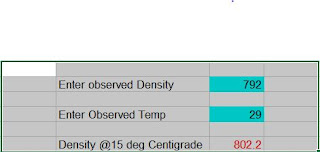-Gasoline Reid Vapor Pressure (RVP) prediction from Distillation data
-Gasoline Reid Vapor Pressure (RVP) prediction from Distillation data
Predicted RVP values from Initial Boiling Point (IBP) is useful as an easy way for using the same for volatility calculations like emission product loss, product handling at different temperature etc.Gasoline vapor pressure is due to light hydrocarbons or more volatile part of Gasoline. As per definition RVP is the vapor pressure expressed at 37.8 deg C ( 100 deg F) in specified equipment conditions. Incidentally, this is the temperature around which ASTM D 86 Initial Boiling Point (IBP) is observed for Gasoline samples.
Luckily for us, the smooth performance of gasoline fuel in internal combustion engine and environment restriction of volatile emissions desires typical lighter hydrocarbon components in gasoline. These aspects are controlled by Gasoline specification by having minimum and maximum Vapor pressure, minimum lighter hydrocarbon controlled by front end distillation parameters (min 10% evaporation at 70 deg C), achieving min Octane rating number with type of hydrocarbons having higher Octane number (isopentane) in the absence of Tetra Ethyl Lead (TEL) and alcohol blending contributing to Vapor pressure.
All the above mentioned factors have contributed today so that most of gasolines will have Initial boiling temperature (IBP) in a range of 30 to 44 deg C, with exception of D & E class Gasoline having higher vapor pressure for winter months for colder geographical areas ( Vapor pressure max 13.5 and 15 psa for D & E as per ASTM D 4814 specification). These higher Vapor gasoline have IBP on lower side about 26 to 30 deg C.
Thus Gasoline IBP range ( about 26 to 44 ) can be used for predicting RVP with a high degree of accuracy. The following prediction equation is only for Motor Gasoline without ethanol. It is observed that the equation holds for small ( 3-4 %V) amount of ethnaol, MTBE, as well. Higher percentage of oxidants, equation give result on lower side.
Predicted RVP (psi) from ASTM D86 Auto IBP (deg C)
RVP = 23.68 – 0.446*IBP .................................................(Eq-1)
Predicted RVP (psi) from ASTM D86 Manual IBP (deg C)
RVP = 25.24 – 0.464*IBP .................................................(Eq-2)
Predicted RVP (psi) from ASTM D86 Auto IBP (deg C)
RVP = 23.68 – 0.446*IBP .................................................(Eq-1)
Predicted RVP (psi) from ASTM D86 Manual IBP (deg C)
RVP = 25.24 – 0.464*IBP .................................................(Eq-2)
Comparison has been done with the D5191 RVP values of ASTM PTP round robin programs robust mean and predicted as per above equations. In ASTM PTP Gasoline programs about 200 global laboratories participate in proficiency testing.
Accuracy of above prediction will depend off course on accurate determination of IBP. (Reproducibility of D86 IBP is about 6 deg C and for D5191 RVP is about 0.5 psi.)
Following table gives comparison between Predicted RVP as per Eq-1,
and ASTM D86 Auto Initial Boiling Point (IBP).
Accuracy of above prediction will depend off course on accurate determination of IBP. (Reproducibility of D86 IBP is about 6 deg C and for D5191 RVP is about 0.5 psi.)
Following table gives comparison between Predicted RVP as per Eq-1,
and ASTM D86 Auto Initial Boiling Point (IBP).
ASTM PTP
|
Auto 86
|
RVP
|
||
Round Robin
|
IBP
|
D5191
|
Calc, Eq-1
|
difference
|
( 2010-2016)
|
Deg C
|
psi
|
psi
|
psi
|
MG1012
|
34.6
|
8.8
|
8.2
|
0.6
|
MG1212
|
31.5
|
9.9
|
9.6
|
0.3
|
MG1304
|
40.1
|
5.8
|
5.8
|
0.0
|
MG1308
|
37.8
|
6.4
|
6.8
|
-0.4
|
MG1404
|
28.5
|
11.6
|
11.0
|
0.6
|
MG1408
|
30.8
|
9.2
|
9.9
|
-0.7
|
MG1504
|
32.2
|
8.7
|
9.3
|
-0.7
|
MG1508
|
36.5
|
7.0
|
7.4
|
-0.4
|
MG1512
|
35.6
|
7.3
|
7.8
|
-0.5
|
MG1604
|
28.3
|
11.4
|
11.0
|
0.3
|
MG1608
|
40.8
|
6.2
|
5.5
|
0.7
|
Following table gives comparison between Predicted RVP as per Eq-2,
and ASTM D86 Manual Initial Boiling Point (IBP).
and ASTM D86 Manual Initial Boiling Point (IBP).
ASTM PTP
|
Manual D86
|
RVP
|
||
Round
Robin
|
IBP
|
D5191
|
Calc, Eq-2
|
Difference
|
( 2010-2016)
|
Deg C
|
psi
|
psi
|
psi
|
MG1012
|
36.0
|
8.8
|
8.5
|
0.3
|
MG1212
|
32.9
|
9.9
|
10.0
|
-0.1
|
MG1304
|
41.8
|
5.8
|
5.9
|
0.0
|
MG1308
|
40.0
|
6.4
|
6.7
|
-0.3
|
MG1404
|
31.1
|
11.6
|
10.8
|
0.7
|
MG1408
|
33.4
|
9.2
|
9.7
|
-0.5
|
MG1504
|
35.2
|
8.7
|
8.9
|
-0.3
|
MG1508
|
38.8
|
7.0
|
7.2
|
-0.2
|
MG1512
|
37.6
|
7.3
|
7.8
|
-0.5
|
MG1604
|
30.0
|
11.4
|
11.3
|
0.1
|
MG1608
|
42.6
|
6.2
|
5.5
|
0.7
|
References : ASTM PTP
ASTM D 5191
Author's Profile
List of all blog articles on Petroleum QC by RJ Patel.
Follow me on twitter @RJPatel13 to get notification when my new post is available in my blog.


Comments